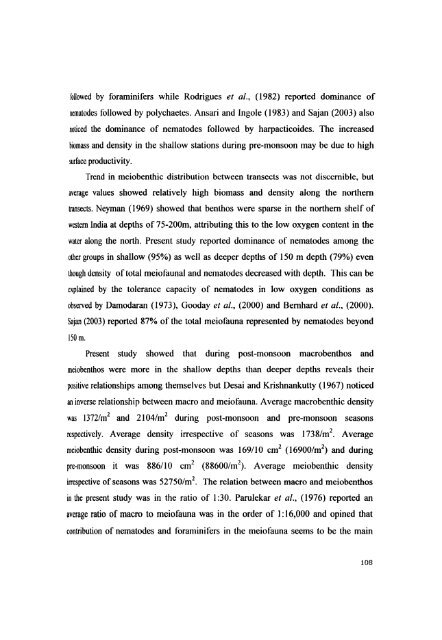L - Cochin University of Science and Technology
L - Cochin University of Science and Technology
L - Cochin University of Science and Technology
You also want an ePaper? Increase the reach of your titles
YUMPU automatically turns print PDFs into web optimized ePapers that Google loves.
followed by foraminifers while Rodrigues et al., (1982) reported dominance <strong>of</strong><br />
nematodes followed by polychaetes. Ansari <strong>and</strong> Ingole (1983) <strong>and</strong> Sajan (2003) also<br />
noticed the dominance <strong>of</strong> nematodes followed by harpacticoides. The increased<br />
biomass <strong>and</strong> density in the shallow stations during pre-monsoon may be due to high<br />
surface productivity.<br />
Trend in meiobenthic distribution bctween transects was not disccrnible, but<br />
average values showed relatively high biomass <strong>and</strong> density along the northern<br />
transects. Neyman (1969) showed that benthos were sparse in the northern shelf <strong>of</strong><br />
wcstern India at depths <strong>of</strong> 75-200m, attributing this to the low oxygen content in the<br />
water along the north. Present study reported dominance <strong>of</strong> nematodes among the<br />
other groups in shallow (95%) as well as deeper depths <strong>of</strong> 150 m depth (79%) even<br />
though density <strong>of</strong> total mei<strong>of</strong>aunal <strong>and</strong> nematodes decreased with depth. This can be<br />
explained by the tolerance capacity <strong>of</strong> nematodes in low oxygen conditions as<br />
observed by Damodaran (1973), Gooday et al., (2000) <strong>and</strong> Bernhard et al., (2000).<br />
Sajan (2003) reported 87% <strong>of</strong> the total mei<strong>of</strong>auna represented by nematodes beyond<br />
150 m.<br />
Present study showed that during post-monsoon macrobenthos <strong>and</strong><br />
meiobenthos were more in the shallow depths than deeper depths reveals their<br />
positive relationships among themselves but Desai <strong>and</strong> Krishnankutty (1967) noticed<br />
an inverse relationship between macro <strong>and</strong> mei<strong>of</strong>auna. Average macrobenthic density<br />
was 1372/m 2 <strong>and</strong> 2104/m 2 during post-monsoon <strong>and</strong> pre-monsoon seasons<br />
respectively. Average density irrespective <strong>of</strong> seasons was I 738/m 2 . Average<br />
meiobenthic density during post-monsoon was 169/10 cm 2 (16900/m2) <strong>and</strong> during<br />
pre-monsoon it was 886/10 cm 2 (88600/m2). Average meiobenthic density<br />
irrespective <strong>of</strong> seasons was 52750/m 2 • The relation between macro <strong>and</strong> meiobenthos<br />
in the present study was in the ratio <strong>of</strong> 1 :30. Parulekar et al., (1976) reported an<br />
average ratio <strong>of</strong> macro to mei<strong>of</strong>auna was in the order <strong>of</strong> 1: 16,000 <strong>and</strong> opined that<br />
contribution <strong>of</strong> nematodes <strong>and</strong> foraminifers in the mei<strong>of</strong>auna seems to be the main<br />
108

















